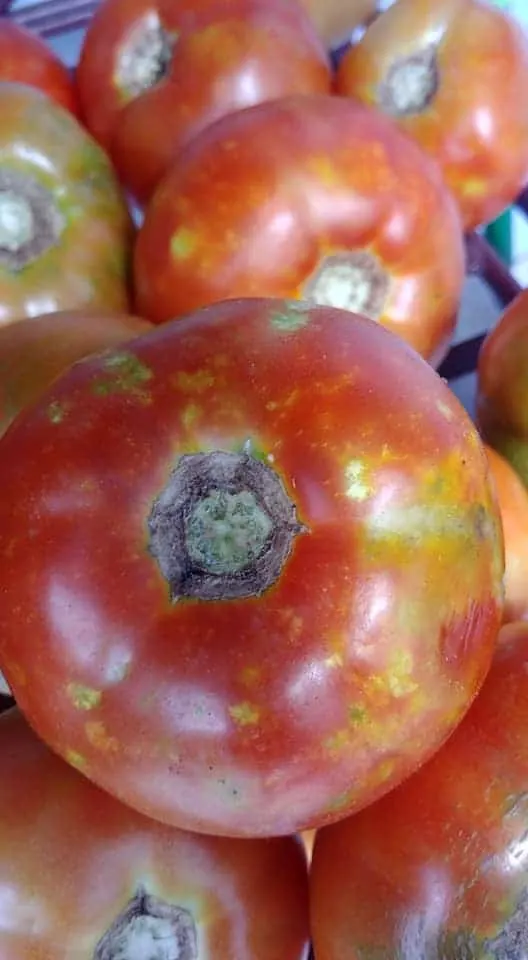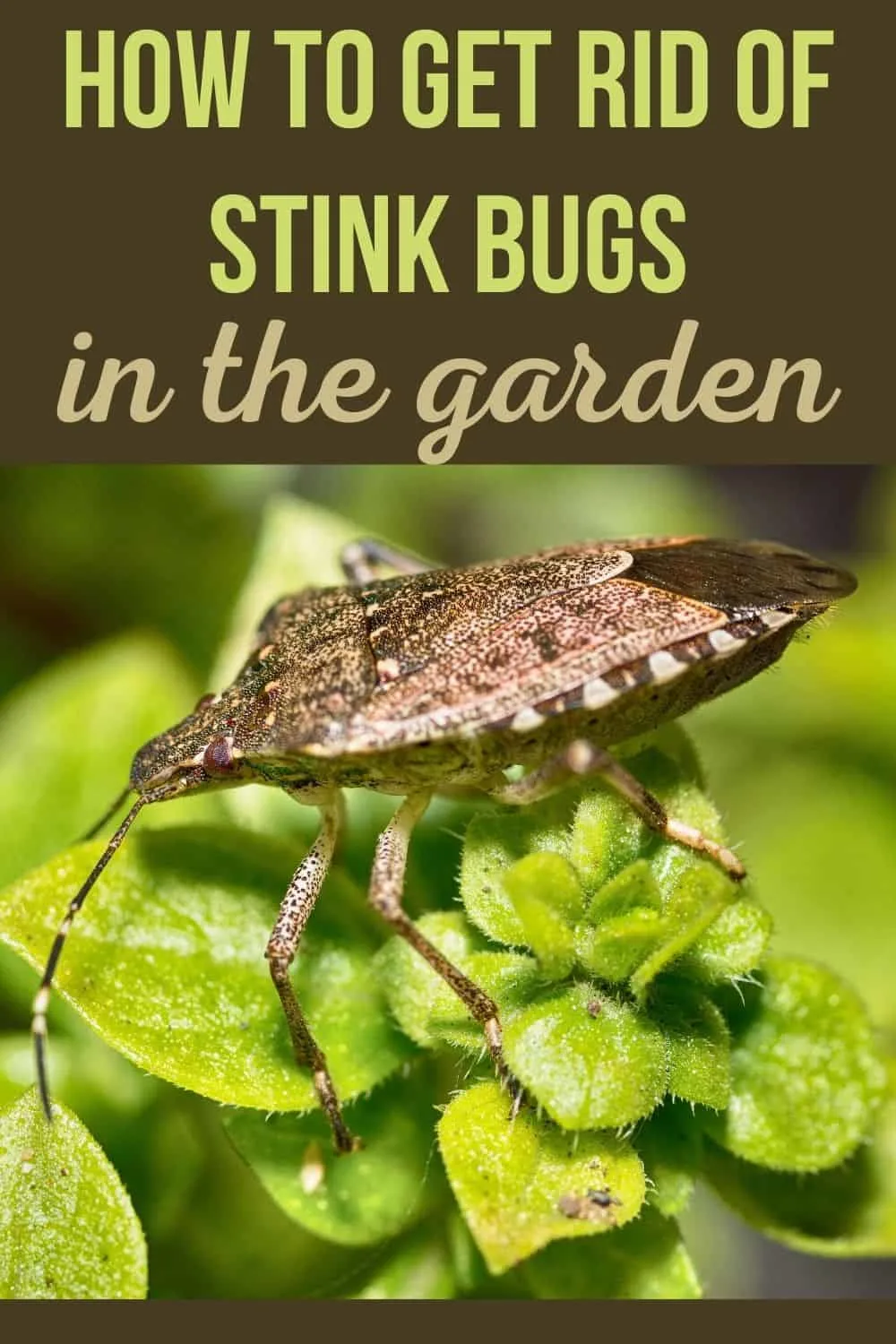It’s bad enough when they show up in your house, but the real damage occurs when stink bugs begin munching away at the plants in your garden. If you think you have a stink bug infestation, read on to learn how to confirm their presence and how to get rid of stink bugs in the garden.

How to Get Rid of Stink Bugs in the Garden
How to identify stink bugs
Before taking measures to eradicate stink bugs, let’s first make sure you have correctly identified the culprits. Stink bugs have broad, shield-shaped bodies. While there are many types, most are mottled brown, though one species is green. The invasive brown marmorated stink bug can be distinguished from native species by the white bands on its antennae and legs and along the back edges of its abdomen. Stink bugs look a bit like squash bugs, but they have broader bodies.
In spring, stink bugs lay hundreds of barrel-shaped eggs in clusters on the undersides of leaves. The roundish nymphs hatch with orange abdomens that mature to a darker shade. As their development takes about five weeks, you will likely see adult stink bugs in the spring and again in late summer. As cool weather approaches in the fall, you may begin to find them in outbuildings and even your house.
What stink bug damage looks like

Predatory stink bugs do exist, so look both at the appearance of the insects as well as the damage they create. Stink bug nymphs and adults feed on more than 200 species of plants, using a straw-like mouth part to puncture plant tissue and suck out the juices. This causes discoloration and deformation of fruit, including apples, beans, eggplants, grapes, peppers, corn, swiss chard, and tomatoes. Look specifically for spots that appear to be pinpricks surrounded by yellow or green.
How to control stink bugs
If you confirm that stink bugs have infested your garden and caused harm to your plants, you will want to take steps to control these smelly pests. The good news is you have a few options to choose from:
1. Keep the garden clean
As with many insect pests, stink bugs overwinter in garden debris and lay eggs on tall weeds. A great measure of prevention against these pests, then, is to keep the garden tidy.
Pull weeds regularly, remove any plant debris to a compost or burn pile, and mow any surrounding grass. Logs, boards, and other potential hiding places should also be removed from the garden.
While cleanliness is especially important toward the beginning and end of the season, it should be maintained all summer as well.
2. Hand-pick early
As soon as you notice stink bugs in the garden, begin picking them off the plants by hand. Rather than crush them, which causes the insects to release a foul odor, drop them into a container of soapy water. I find that quart-sized yogurt cups or takeout containers work well.
Not only does this remove individual stink bugs from the garden, but it also prevents them from reproducing. The earlier you begin picking them, the fewer stink bugs you will see later.
3. Plant a trap crop
If you have enough space, consider planting a trap crop to entice the stink bugs away from your desired plants. Plant a small section of an enticing crop in or near the garden, and once the stink bugs flock to it, pull up the plants and stuff them into a garbage bag – bugs and all – then leave it in the sun for a few days to “bake.” You can then dump the bag in the garbage or, to prevent sending more stuff to the landfill, just empty the contents onto a weed or burn pile.
Some plants that stink bugs especially like and that will make excellent trap crops include the following:
- amaranth
- mustard
- okra
- sunflower
- sweet corn
4. Use repellents
A few natural repellent options exist to keep stink bugs out of the garden. One of the best options is to spray the plants with a kaolin clay solution. This will prevent stink bugs from not only eating the plants but also laying eggs on the foliage.
Alternatively, you can spray plants (and the stink bugs on them) with soapy water or a store-bought natural repellent. Look for OMRI-certified products for use in vegetable gardens and to avoid unnecessary toxins in general.
5. Encourage beneficial insects
Despite their foul odor, stink bugs have multiple predators that you can attract to the garden to help keep stink bug populations at a minimum. An abundance of shallow nectar-producing flowers planted around the garden will attract a range of beneficial insects, but you can include some specific plants to encourage stink bug predators. Buckwheat, for instance, attracts ladybugs and parasitic wasps and flies that attack stink bugs. Add a bird bath and toad house to encourage larger predators as well.
6. Spray organic pesticide
Pesticides should only ever be used as a last resort. Try the above options first, and if those don’t work and you find yourself at your wit’s end, come back to this final option.
As with repellents, look for OMRI-certified organic pesticides such as neem oil, insecticidal soap, pyrethrin, or rotenone. Keep in mind that any kind of pesticide can affect beneficials as well as the targeted pest.
I hope these tips help you get the stink bugs out of your garden so you can focus more on the plants and enjoying the fruits (and veggies!) of your labor.

Serena Manickam is a freelance editor and writer and sustainable market gardener in rural Virginia. She holds a BA in environmental science and runs Fairydiddle Farm, a small market garden in which she grows no-spray produce and herbs to sell at a local farmer’s market.


What Are Harlequin Bugs? And 6 Ways To Control These Pretty Pests
Tuesday 21st of June 2022
[…] Here’s how to get rid of stink bugs from your garden. […]
How To Get Rid Of Squash Bugs Naturally - 7 Easy Tips
Friday 16th of July 2021
[…] you familiar with stink bugs (learn how to get rid of stink bugs in the garden)? These insects get their name because they put off a very foul odor when they are killed. Squash […]